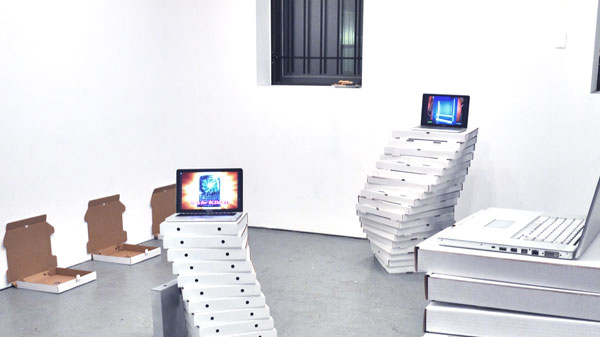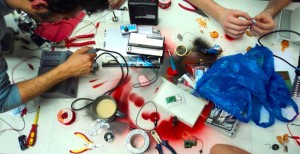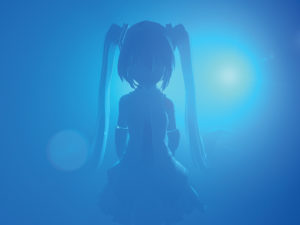A proponent of the post-internet era, Ottawa-born, Hong Kong-raised, Syracuse (via Toronto) based Net artist Jennifer Chan is sipping a Club-Mate in the café of Berlin’s Haus der Kulturen der Welt. It’s an early morning chat for the young practitioner, in Germany to present her [[[ I’ll Show You HD ]]] exhibition, featuring a stream of decontextualised online imagery that reflects and remixes the accelerated attention spans created by the Online environment. Employing a uniquely amateur aesthetic in the form of a slideshow, or ‘powerpoint presentation’, Chan uses these methods to explore and critique increasingly pervasive digital forms, their modes of mediation and the agency of the user.
A 9:30am start during a week of long nights and hectic schedules at this year’s transmediale, Chan is well-groomed and surprisingly clear-minded. Summarising her interests and motivations as an artist in an easy five-minute opening, it’s obvious that she’s given a lot of thought to properly articulating her ideas: “sorry if this is a lot of information. You can stop me.” But there’s more to Jennifer Chan than a semi-rehearsed dialectic outlining her artistic practice.
Not only an artist working within so-called ‘new media’, Chan is also a self-described ‘amateur cultural critic’, inspired by curators and scholars Sarah Cook and Beryl Graham, and a feminist whose pieces (like the titillatingly-titled ‘An Informal Survey of Swag: The Sociology of Hip Hop In the Micro-World of Emerging Net Art‘) have appeared online through publications like Art Fag City and Rhizome. She’s a part of that “academic cluster” of prosumers, centered around the North American regions of Chicago and New York, where she’s currently completing a Masters of Fine Arts in Video at Syracuse University. It’s from here that Chan explores ideas of gender and racial identity within a digital medium and (what she affectionately calls “the toilet of the human mind”) the Internet.
What do you think about those people who can and do disregard Net art or web based art, for being just kitsch and pointless?
JC: That’s a common reaction. There have been efforts by many younger curators to make that bridge between Net art and contemporary art. I feel like, with a lot of 2.0, or post-2.0 artists, they are adapting their work into exhibition spaces and they’re creating their own spaces online. Like you mentioned, Tabor Robak and, some of his friends, Kari Altmann and Amalia Ulman… A lot of people are working to create their own internet art galleries. In Berlin there’s Future Gallery that shows pretty much just web-based work but it also looks hyper-contemporary. I’ve also been involved in that; curating DIY shows but also curating video screenings with institutions to leverage a new hierarchy, in a way [laughs].
I also share that sentiment of ‘fuck the traditional definitions of contemporary art’, to try to elevate this Internet trash as something worthy of looking at, like, artefact. I think Kari Altmann’s practice is about that; finding these things, creating these memes and looking at them like artefacts.
You obviously approach the Internet quite critically. Having worked with people in their late teens, I’ve found they don’t seem particularly interested. They use it as a tool rather than something to be fascinated by or deconstructed.
JC: It depends on the person. I think that there is no average user but people like to talk about users as this homogenous group; that they’re necessarily going to use and interact with the interface for its functional reasons. There was quite a bit of discussion about that at What Was The User? panel yesterday. Of course, it’s great to hear from people like Olia Lialina and Cornelia Sollfrank on those ideas; those early sentiments of really trying to create systems so people can change the way of making art and challenge authorship. But I think it’s different now, it’s post-2.0 time. They also have very different ideas of the word and the use of the word ‘user’.

Do you think about that uneven distribution of Internet access, globally?
JC: Yeah. I’m aware of the digital divide and it makes me uncomfortable. I went to China in 2008 and 2009. We went through the city in a tour bus and half the city is really developed and the other half is squats and squatter houses. It’s interesting too because, there people might be living in uncomfortable conditions but then they’ll whip out a smartphone or they’ll have a TV. There’s also that privileging of technology or entertainment.
I guess, my work tries to resolve those problems because it’s something that’s almost larger than within what I can do. I think it can raise awareness about that, in the way of looking at technology. I’m really aware that the ‘post-Internet’ revels in that privilege almost; of the Internet’s role in the First World.
You’ve also said you disagree with the term ‘digital native’, especially when you don’t know how to code or programme. It’s easy to forget that the Internet, on the whole, is founded on a space built by mostly male programmers.
JC: I have a piece of work about that in the exhibition. It’s called ‘*A Total Jizzfest*’. It’s a rough history of the sexiest and richest computer and Internet scientists, programmers and web 2.0 moguls. I was also looking at their representation over time because Google search stock images of them that are flying in through the video. As well as that, it’s a small research project for me just to understand who did what over the course of time, from the 1950s up until the present.
It seems like, also, the post-web 2.0 or the web 2.0 moguls are way more informal about the way they represent themselves but they’re all brands. Christopher Poole is ‘moot’, the founder of 4chan. Jakob Lodwick, he’s the founder of Vimeo but then there’s a myth around him because of how much personal life is on his Twitter account, also blog posts and emails are made public by people he’s dated. I find all that really juicy. I’m really interested in this human dimension around technology and how people approach the social web.
You mentioned Marisa Olson defining ‘post-internet’ culture as a new mode where communication and socialisation is a part of every day life. Do you think it’s important to continue to explore and critique the racial and gender conventions that still exist on the Internet?
JC: I think that there are artists that are querying those dichotomies or conventions. I guess, in music, it’s Mykki Blanco and Le1f… I really like his work. I think it’s possible to look at various representations of masculinity and femininity through a queer lens online. As well as just understanding that people selectively appropriate various orthodox definitions of masculinity and femininity, in a pleasurable way. I don’t think they’re strictly adhering to them all the time but it’s definitely questionable when someone posts something that looks heteronormative, or whatever, what that means…
I can’t speak for the general Internet art community, in terms of what their ideas about orientation are, but from just embodying different identities in chat forums when I was 14, when there wasn’t any live video chat yet, I recognised that certain spaces online that are meant for everyone are highly gendered in terms of language. Even on [online dating site] OkCupid, the advertising sometimes targets me as a really feminine woman. Other times it targets me as a man; where it’s really important for me to own a Lexus or something.
For me, it’s an understanding that many spaces are very gendered and knowing how I can talk about that. It’s important to remember that it’s a condition of half-internalising these ideas of being a particular kind of user, which these websites think that I am.
Net art seems to have had a more pervasive impact on the US because of its traditional role as a global economic centre. Do you think growing up in Hong Kong has had a similar effect on your outlook as an artist?
JC: Yeah, I suppose. I guess it’s a certain kind of Net art, which is very cosmopolitan or ‘blanket international’, that has definitely influenced me. Just growing up in different cultures has influenced my ideas of how to appropriate, what to appropriate, what can I appropriate? Yeah, definitely this ‘global feel’.
I’m actually thinking about Energy Pangea, who make work like Kari Altmann, they’re really looking at images of globalisation: African kids, images of different national flags and the way that it’s almost removed from what they usually mean. It’s almost this very corporate aesthetic, very designer-y and slick, which is not like mine but I think about looking at things that way too; almost everything as a brand, a potential product or commodity and ultimately an experience.
There’s always more than one way of looking at something; whether it’s Net art and its creative worth, or the critique of globalisation and corporate culture by embodying it. There seems to be this unsettling awareness that there’s nothing that can’t be commodified. Rihanna doing #seapunk is a good example.
JC: Everything’s susceptible to reappropriation and shifts in meaning. I think that comes with just working within this networked community. It’s so rapid in terms of its responses but then groups of people have the agency to respond and talk back to it. I don’t think it’s the end of an aesthetic because Rihanna’s appropriated it. If you put your work online, then it’s going to travel. Nick Briz made this rotoscoped and green-screened Rihanna video, where people were making response videos as well.
Do you think that ‘right of reply’ is specific to the digital era, that conversation?
JC: I think it is but a lot of the times it stays online. I suppose it does end up being heard of outside of the internet art community when it reaches more mainstream media forms. Like, I’m thinking if it hits an art blog, or a lifestyle blog, then people find out that #seapunk was incorporated, or a glitch aesthethic was incorporated into a mainstream music video. I think those are all great dialogues between niche subcultures on the Internet and mainstream media.**



















